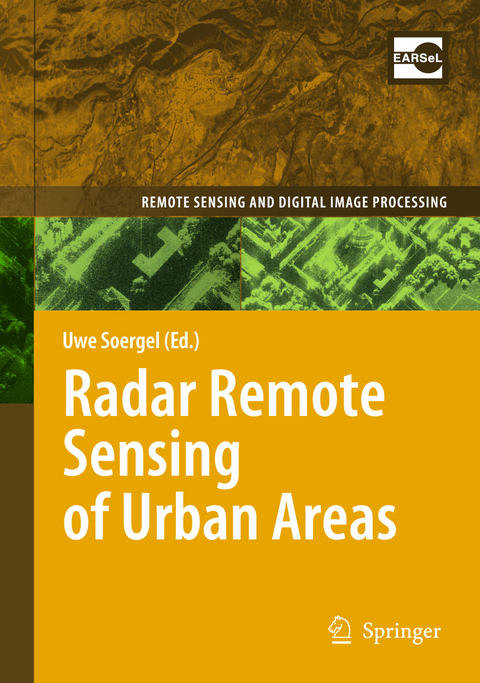
Radar Remote Sensing of Urban Areas
Seiten
2012
|
2010 ed.
Springer (Verlag)
978-94-007-3172-1 (ISBN)
Springer (Verlag)
978-94-007-3172-1 (ISBN)
One of the key milestones of radar remote sensing for civil applications was the launch of the European Remote Sensing Satellite 1 (ERS 1) in 1991. Differential SAR Interferometry based on time series of imagery of the ERS satellites and their successor Envisat became an important and unique technique for surface defor- tion monitoring.
One of the key milestones of radar remote sensing for civil applications was the launch of the European Remote Sensing Satellite 1 (ERS 1) in 1991. The platform carried a variety of sensors; the Synthetic Aperture Radar (SAR) is widely cons- ered to be the most important. This active sensing technique provides all-day and all-weather mapping capability of considerably ?ne spatial resolution. ERS 1 and its sister system ERS 2 (launch 1995) were primarily designed for ocean app- cations, but soon the focus of attention turned to onshore mapping. Examples for typical applications are land cover classi?cation also in tropical zones and mo- toring of glaciers or urban growth. In parallel, international Space Shuttle Missions dedicated to radar remote sensing were conducted starting already in the 1980s. The most prominent were the SIR-C/X-SAR mission focussing on the investigation of multi-frequency and multi-polarization SAR data and the famous Shuttle Radar Topography Mission (SRTM). Data acquired during the latter enabled to derive a DEM of almost global coverage by means of SAR Interferometry. It is indispe- ableeventodayandformanyregionsthebestelevationmodelavailable. Differential SAR Interferometry based on time series of imagery of the ERS satellites and their successor Envisat became an important and unique technique for surface defor- tion monitoring. The spatial resolution of those devices is in the order of some tens of meters.
One of the key milestones of radar remote sensing for civil applications was the launch of the European Remote Sensing Satellite 1 (ERS 1) in 1991. The platform carried a variety of sensors; the Synthetic Aperture Radar (SAR) is widely cons- ered to be the most important. This active sensing technique provides all-day and all-weather mapping capability of considerably ?ne spatial resolution. ERS 1 and its sister system ERS 2 (launch 1995) were primarily designed for ocean app- cations, but soon the focus of attention turned to onshore mapping. Examples for typical applications are land cover classi?cation also in tropical zones and mo- toring of glaciers or urban growth. In parallel, international Space Shuttle Missions dedicated to radar remote sensing were conducted starting already in the 1980s. The most prominent were the SIR-C/X-SAR mission focussing on the investigation of multi-frequency and multi-polarization SAR data and the famous Shuttle Radar Topography Mission (SRTM). Data acquired during the latter enabled to derive a DEM of almost global coverage by means of SAR Interferometry. It is indispe- ableeventodayandformanyregionsthebestelevationmodelavailable. Differential SAR Interferometry based on time series of imagery of the ERS satellites and their successor Envisat became an important and unique technique for surface defor- tion monitoring. The spatial resolution of those devices is in the order of some tens of meters.
Review of Radar Remote Sensing on Urban Areas.- Rapid Mapping Using Airborne and Satellite SAR Images.- Feature Fusion Based on Bayesian Network Theory for Automatic Road Extraction.- Traffic Data Collection with TerraSAR-X and Performance Evaluation.- Object Recognition from Polarimetric SAR Images.- Fusion of Optical and SAR Images.- Estimation of Urban DSM from Mono-aspect InSAR Images.- Building Reconstruction from Multi-aspect InSAR Data.- SAR Simulation of Urban Areas: Techniques and Applications.- Urban Applications of Persistent Scatterer Interferometry.- Airborne Remote Sensing at Millimeter Wave Frequencies.
| Erscheint lt. Verlag | 5.5.2012 |
|---|---|
| Reihe/Serie | Remote Sensing and Digital Image Processing ; 15 |
| Zusatzinfo | 120 Illustrations, black and white; XVI, 278 p. 120 illus. |
| Verlagsort | Dordrecht |
| Sprache | englisch |
| Maße | 155 x 235 mm |
| Themenwelt | Informatik ► Grafik / Design ► Digitale Bildverarbeitung |
| Informatik ► Theorie / Studium ► Künstliche Intelligenz / Robotik | |
| Naturwissenschaften ► Geowissenschaften ► Geografie / Kartografie | |
| Naturwissenschaften ► Geowissenschaften ► Geologie | |
| Schlagworte | object reconstruction • pattern recognition • Radar remote sensing • spatial analysis • Urban Areas |
| ISBN-10 | 94-007-3172-8 / 9400731728 |
| ISBN-13 | 978-94-007-3172-1 / 9789400731721 |
| Zustand | Neuware |
| Haben Sie eine Frage zum Produkt? |
Mehr entdecken
aus dem Bereich
aus dem Bereich
Modelle für 3D-Druck und CNC entwerfen
Buch | Softcover (2022)
dpunkt (Verlag)
34,90 €
alles zum Drucken, Scannen, Modellieren
Buch | Softcover (2024)
Markt + Technik Verlag
24,95 €


